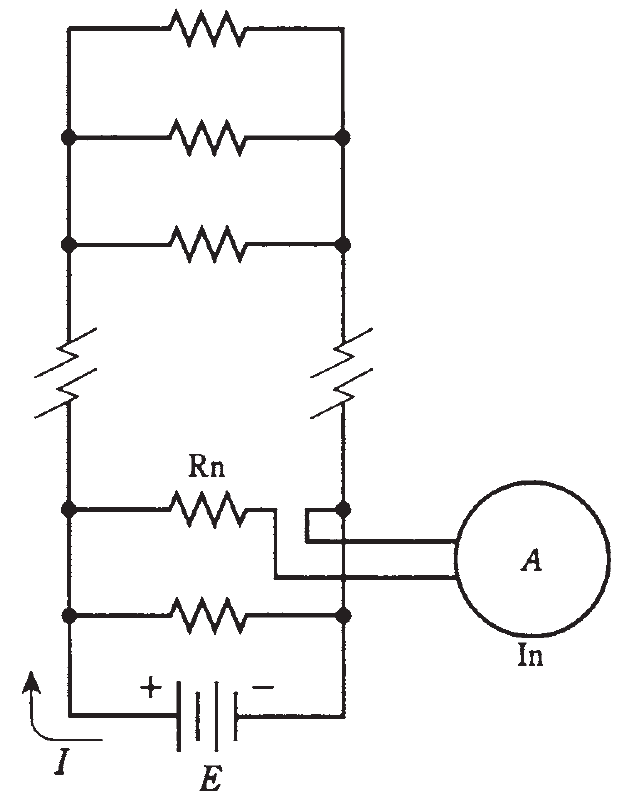


 الفيزياء الكلاسيكية
الفيزياء الكلاسيكية
 الكهربائية والمغناطيسية
الكهربائية والمغناطيسية
 علم البصريات
علم البصريات
 الفيزياء الحديثة
الفيزياء الحديثة
 النظرية النسبية
النظرية النسبية
 الفيزياء النووية
الفيزياء النووية
 فيزياء الحالة الصلبة
فيزياء الحالة الصلبة
 الليزر
الليزر
 علم الفلك
علم الفلك
 المجموعة الشمسية
المجموعة الشمسية
 الطاقة البديلة
الطاقة البديلة
 الفيزياء والعلوم الأخرى
الفيزياء والعلوم الأخرى
 مواضيع عامة في الفيزياء
مواضيع عامة في الفيزياء|
Read More
Date: 3-5-2021
Date: 25-4-2021
Date: 7-4-2021
|
Currents through parallel resistances
Refer to the schematic diagram of Fig. 1. The resistors are called Rn. The total parallel resistance in the circuit is R. The battery voltage is E. The current in branch n, containing resistance Rn, is measured by ammeter A and is called In.

Fig. 1: Analysis of a current in a parallel circuit. See text for dicussion
The sum of all the In’s in the circuit is equal to the total current, I, drawn from the source. That is, the current is divided up in the parallel circuit, similarly to the way that voltage is divided up in a series circuit.
If you’re astute, you’ll notice that the direction of current flow in Fig. 1 is out from the positive battery terminal. But don’t electrons flow out of the minus terminal? Yes— but scientists consider current to flow from plus to minus. This is an example of a mathematical convention or “custom.” Such things often outlast their appropriateness. Back in the early days of electrical experimentation, physicists had to choose a direction for the flow of current, and plus-to-minus seemed more logical than minus-to-plus. The exact nature of electric current flow wasn’t known then. This notation has not been changed. It was feared that tampering with it would just cause confusion; some people would acknowledge the change while others would not. This might lead to motors running the wrong way, magnets repelling when they should attract, transistors being blown out, and other horrors. Just look at the mess caused by the conflict between Fahrenheit and Celsius temperatures, or between miles and kilometers.



|
|
|
|
"عادة ليلية" قد تكون المفتاح للوقاية من الخرف
|
|
|
|
|
|
|
ممتص الصدمات: طريقة عمله وأهميته وأبرز علامات تلفه
|
|
|
|
|
|
|
المجمع العلمي للقرآن الكريم يقيم جلسة حوارية لطلبة جامعة الكوفة
|
|
|